This post may contain affiliate links. Please read our disclosure policy.
These chewy, flexible almond flour tortillas are made with the perfect blend of almond flour and coconut flour for structure that still lets the satisfying mild nutty, buttery flavor shine. And they only have 2 net carbs.
With the addition of a touch of xanthan gum, the finished tortillas are as thin as “regular” flour tortillas, and will bend and fold any way you like. Add your favorite fillings and wrap them up like a burrito that won't break!
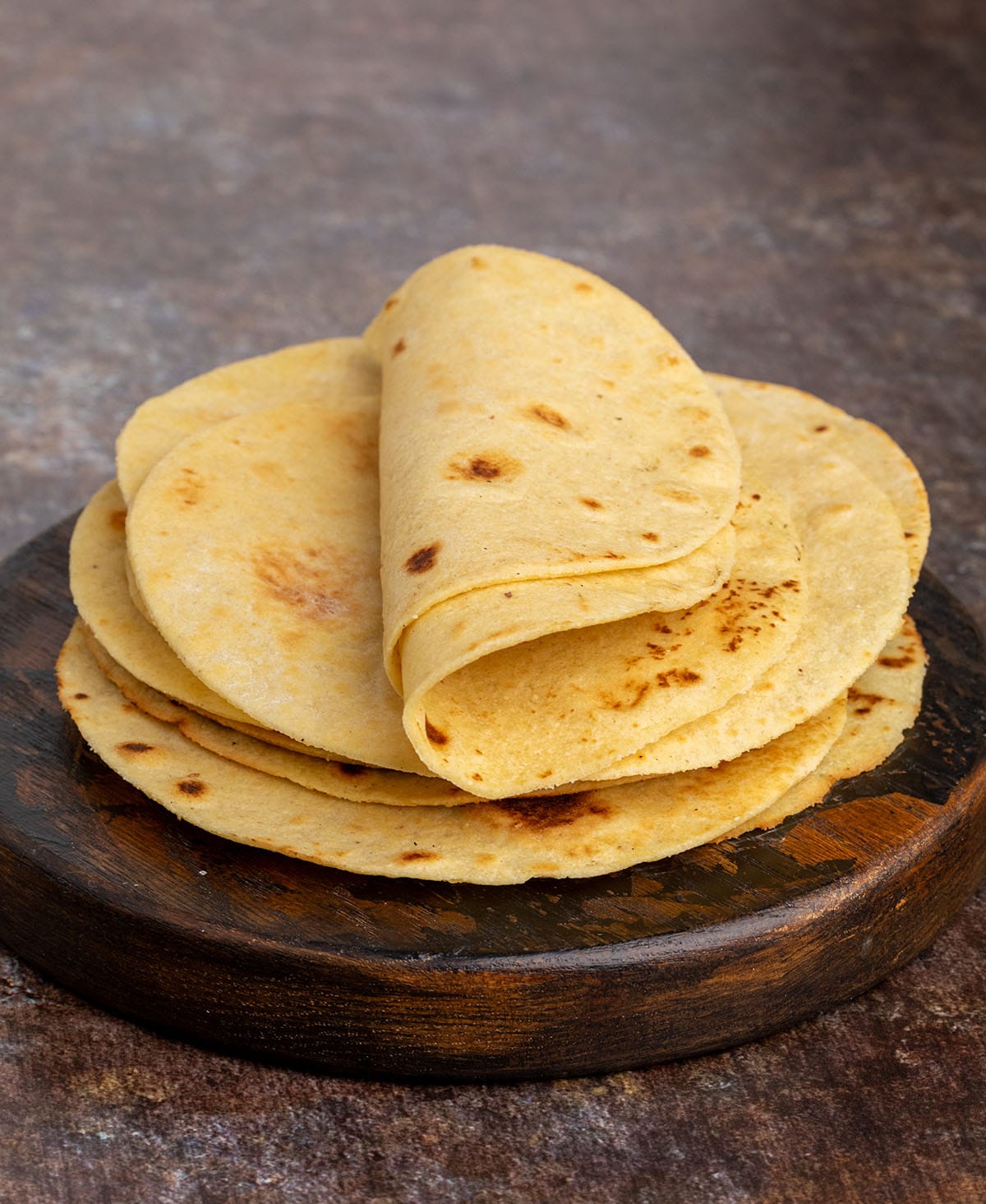
Why this recipe makes the most flexible tortillas
Unlike other recipes you'll find, these almond flour tortillas are rolled paper thin for a tortilla that can be used in any way our regular gluten free tortilla recipe can. You don't have to roll them as thick as flatbread, or have them break as you try to wrap them around fillings.
We add enough coconut flour and a touch of xanthan gum to finely ground almond flour, plus one egg, to create true structure and resilience in both the raw dough and the finished tortillas.
You can make the dough in a mini chop food processor or with just a bowl and spoon, and store it in the refrigerator for up to a week. And the finished tortillas will stay fresh at room temperature for days. Truly an amazing tortilla!
Ingredients explained
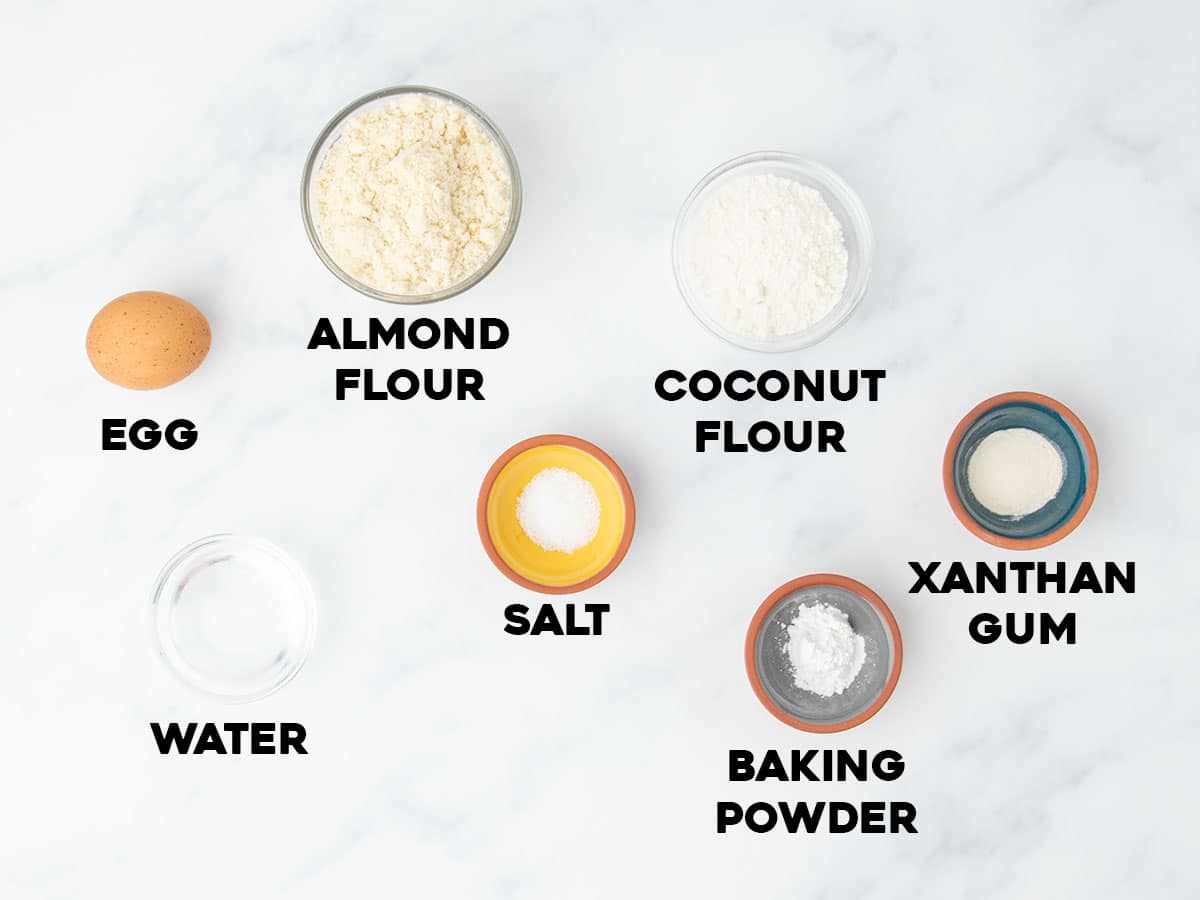
There aren't many ingredients in this recipe, and each contributes something to the tortillas. Here's a bit about the importance and background of each:
- Almond flour: Adds bulk, some structure, and flavor. Because it has so much fat, it's soft, though. Be sure to use finely ground and sifted blanched almond flour like Wellbee's, Blue Diamond, nuts dot com, or Costco's Kirkland brand. Almond meal, which is coarsely ground and the almonds have intact skins, won't bind the dough together properly for a smooth, integrated tortilla.
- Coconut flour: Has a lot of fiber which helps add structure and helps absorb some of the fat from the almond flour, making these two flours into a magic combination of flavor, structure, and low carbohydrates.
- Xanthan gum: Keeps the dough from crumbling so you can roll it out. Without it or a substitute, the raw dough is too soft to hold together long enough to transfer it to the griddle. Xanthan gum is better here than psyllium husk, which can add unwanted flavor and potentially color if not sourced properly.
- Baking powder: Adds rise and gives the tortillas some dimension.
- Salt: Adds taste and brightens the other flavors.
- Egg: Helps to hold the tortillas together, provide structure and some rise, and moisture for water-absorbent coconut flour.
- Water: Just enough to finish bringing the dough together.
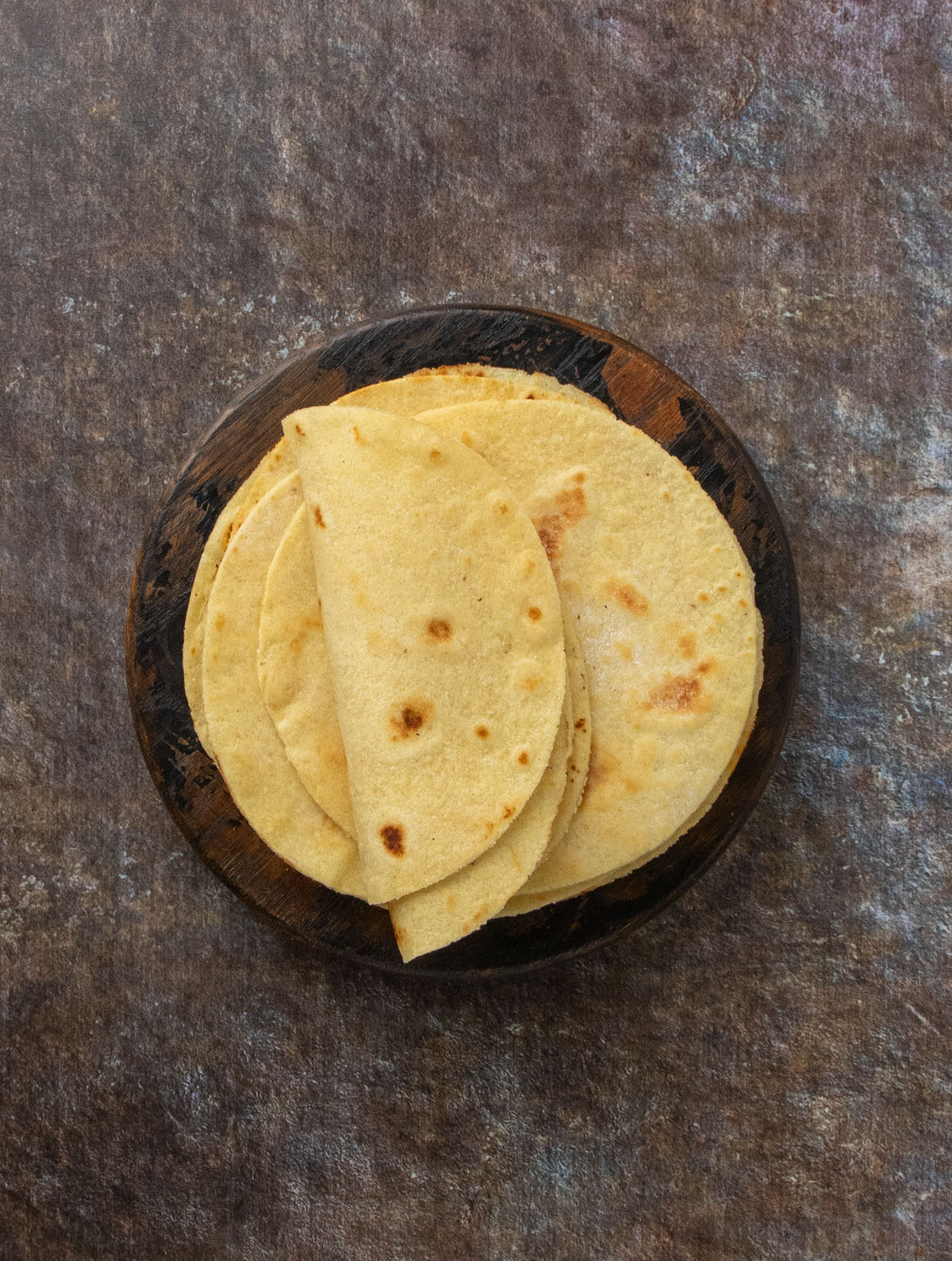
How to make almond flour tortillas
1. Make the dough
Whisk together the almond flour, coconut flour, salt, xanthan gum, and baking powder, then add the beaten egg and 2 tablespoons of water to form a relatively soft dough that feels like extra soft play-doh.
Wrap it tightly in plastic wrap and refrigerate for at least 10 minutes, if not longer. This will make the dough much easier to handle by allowing the coconut flour to absorb the moisture from the egg and water and the fat of the almond flour. It's also less sticky when it's cold.
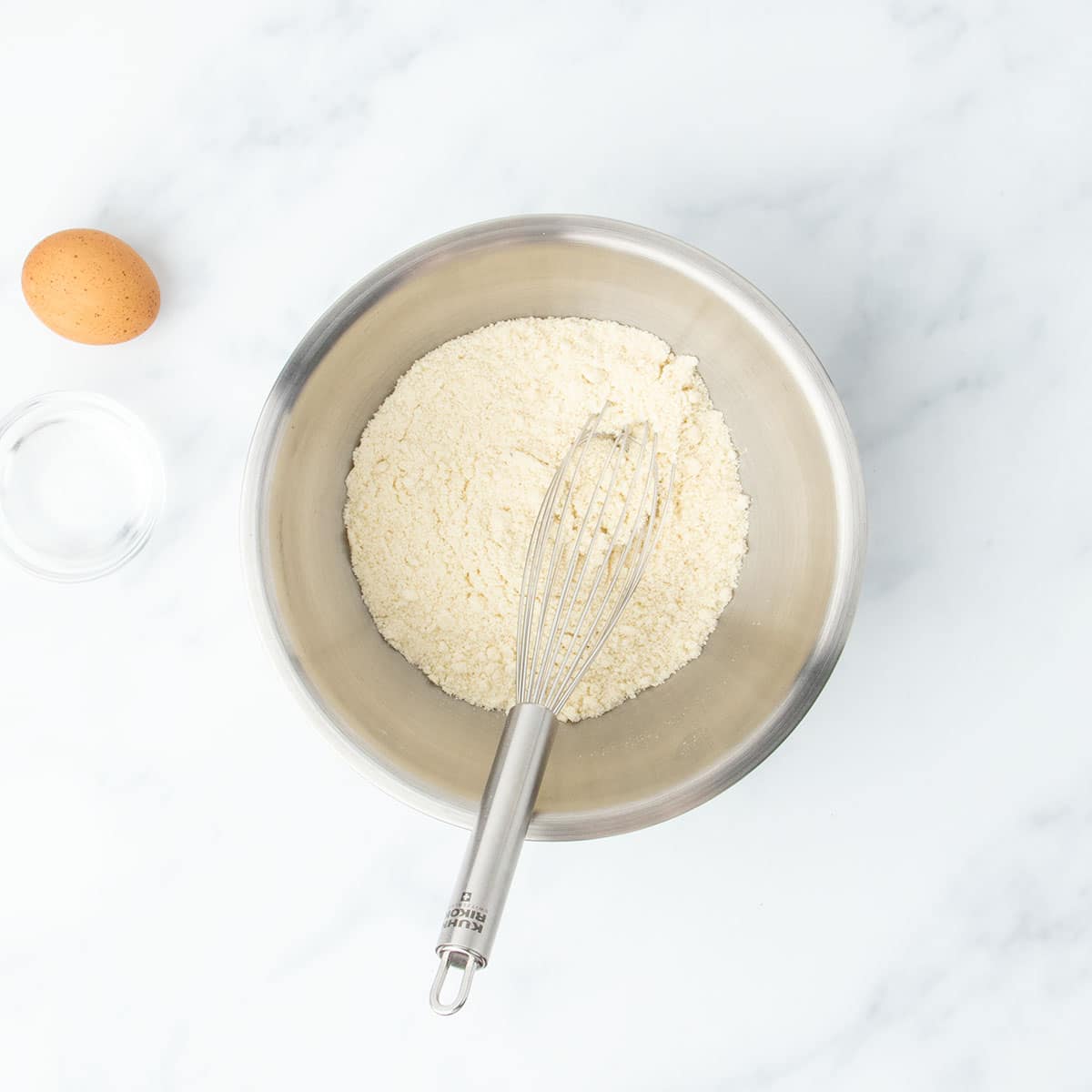
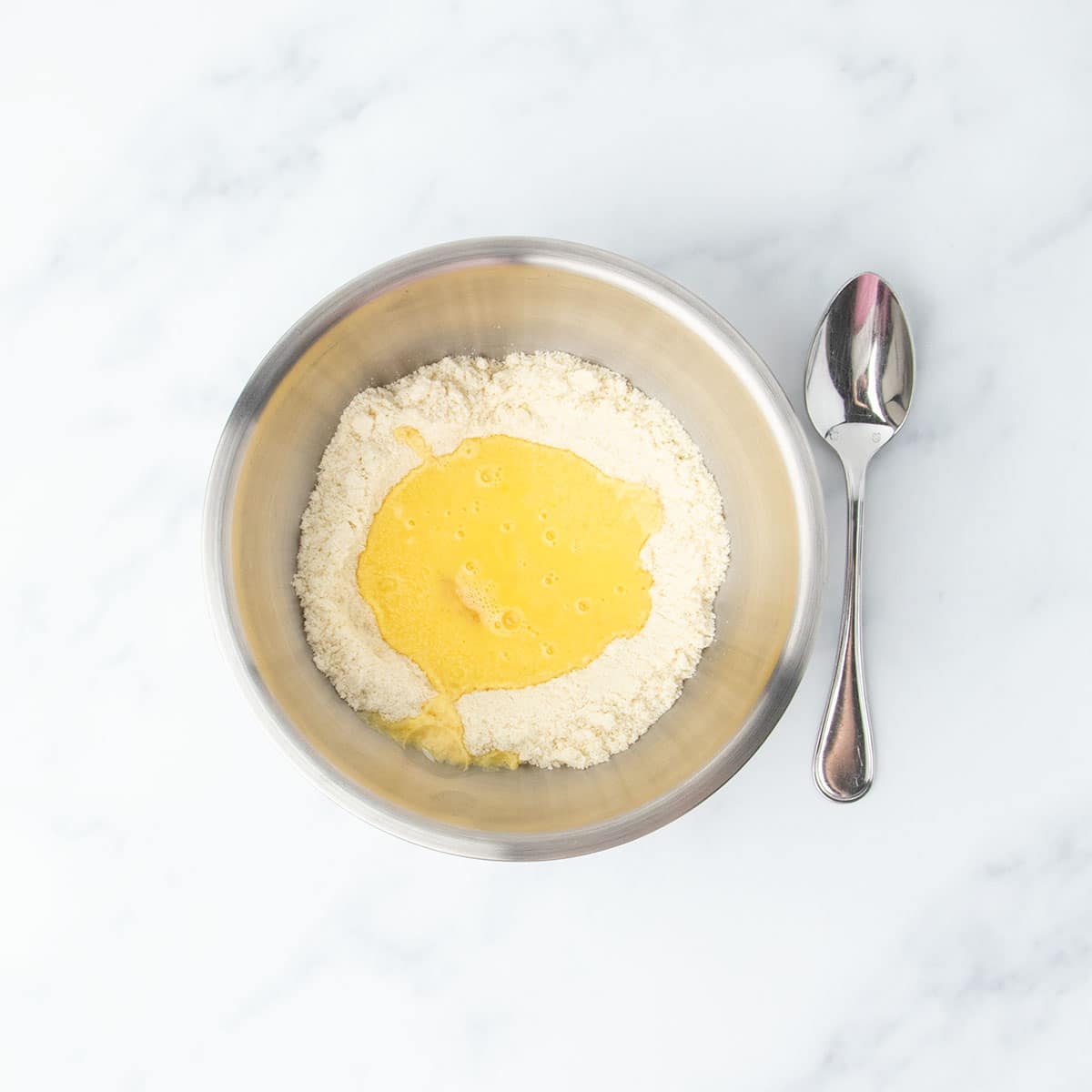
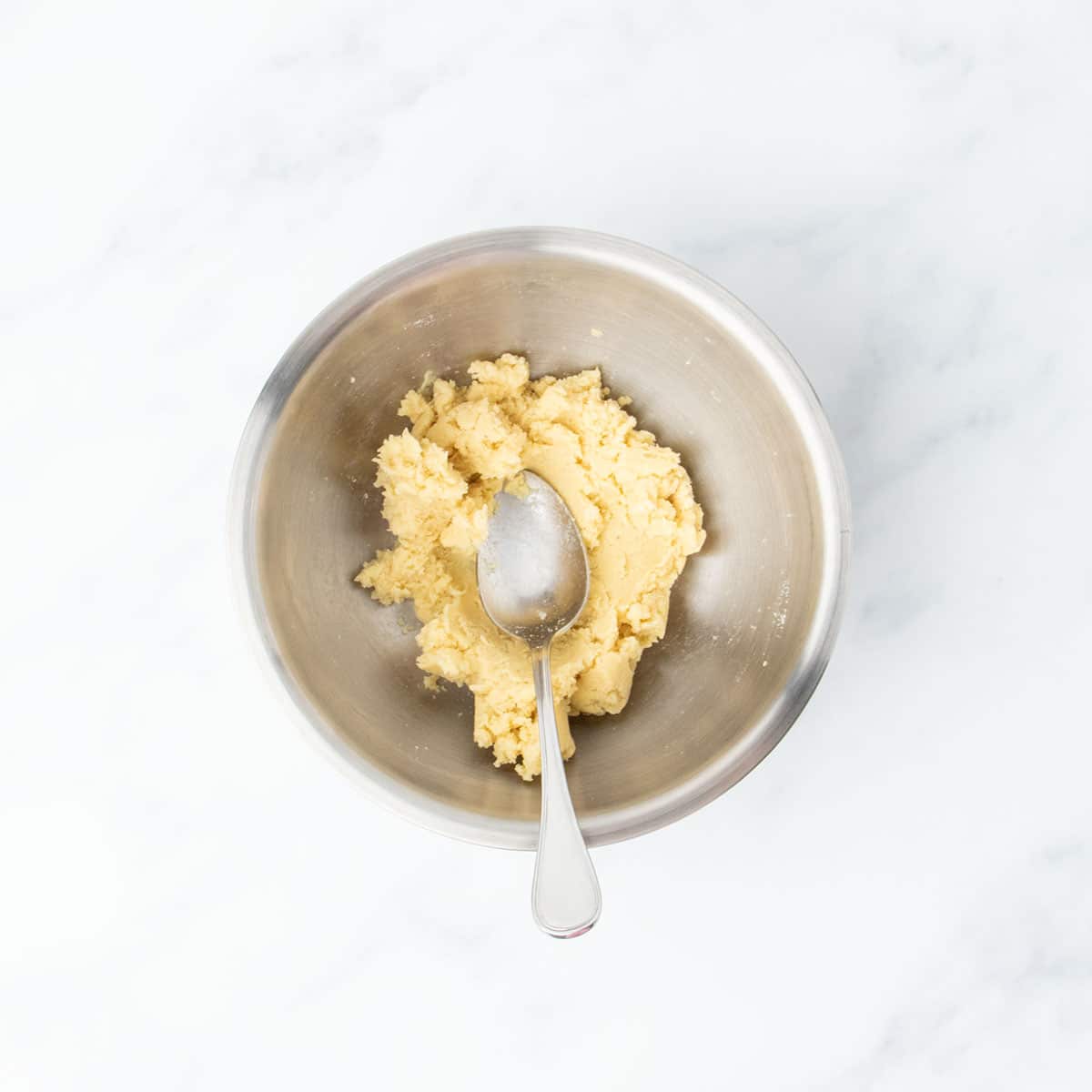
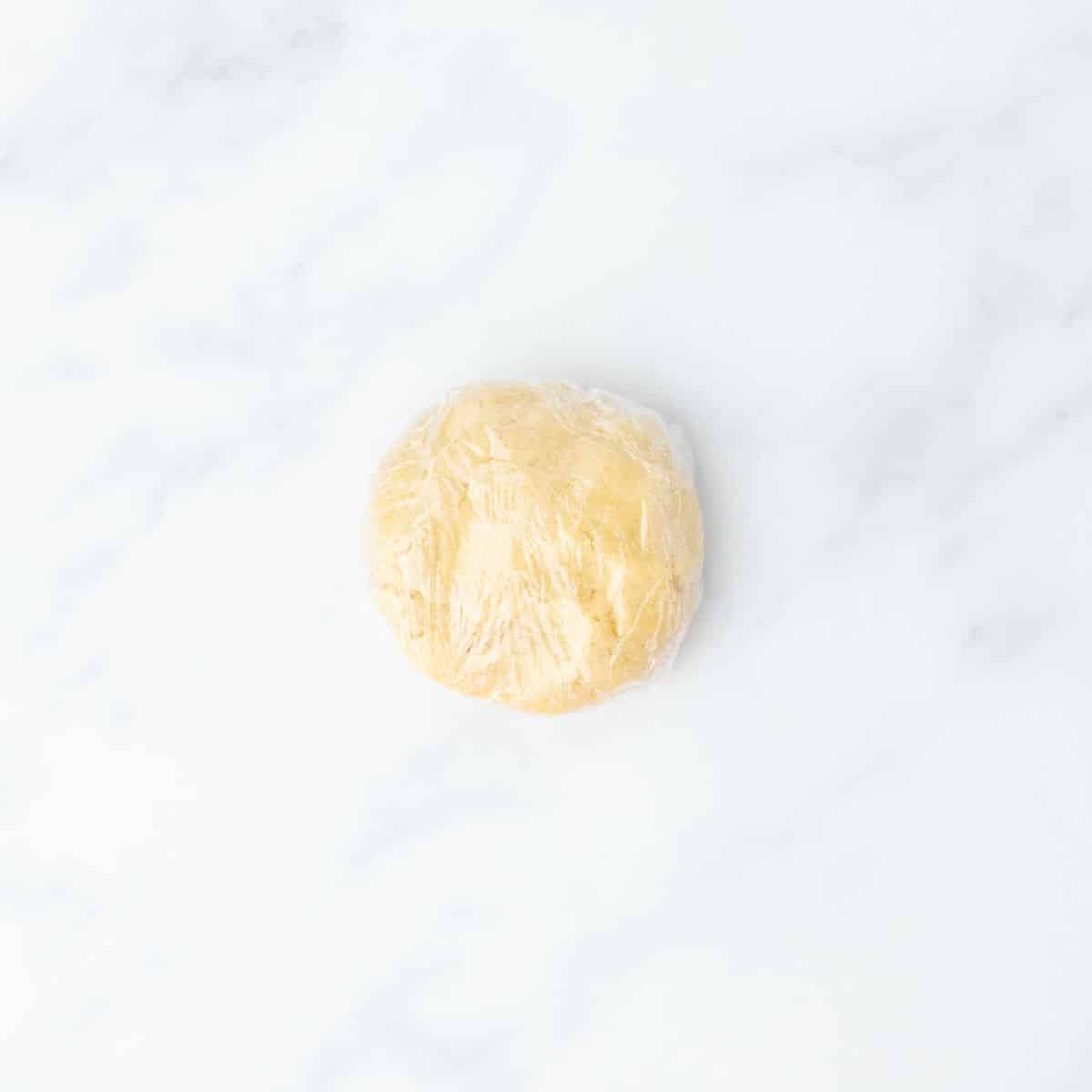
2. Smooth and divide the dough
Unwrap the chilled dough and sprinkle it lightly with tapioca starch. Roll it into a rough rectangle and fold it into a packet at least once to smooth out the dough and make it easier to work with. Use a bench scraper or sharp knife to divide the dough into 8 equal pieces.
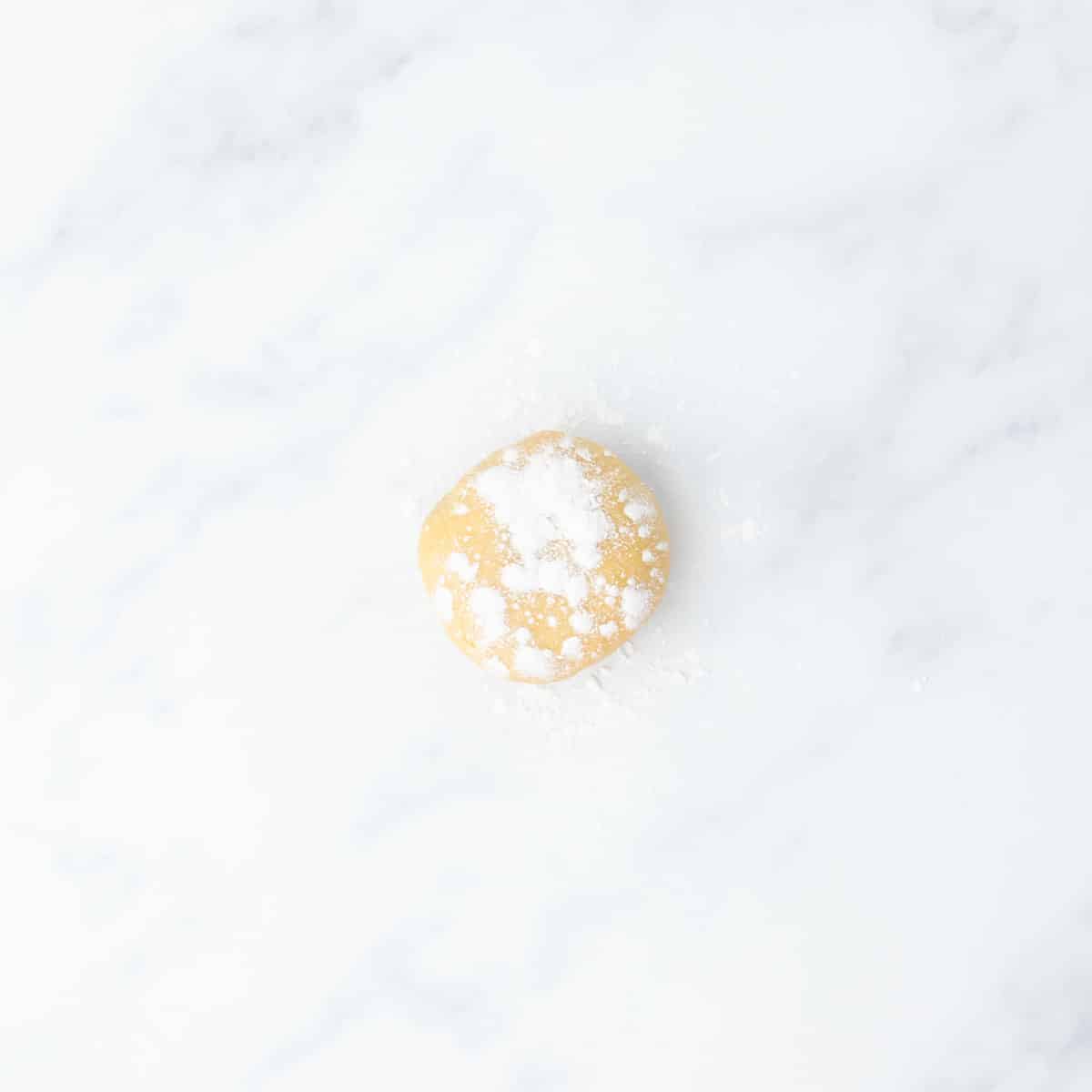
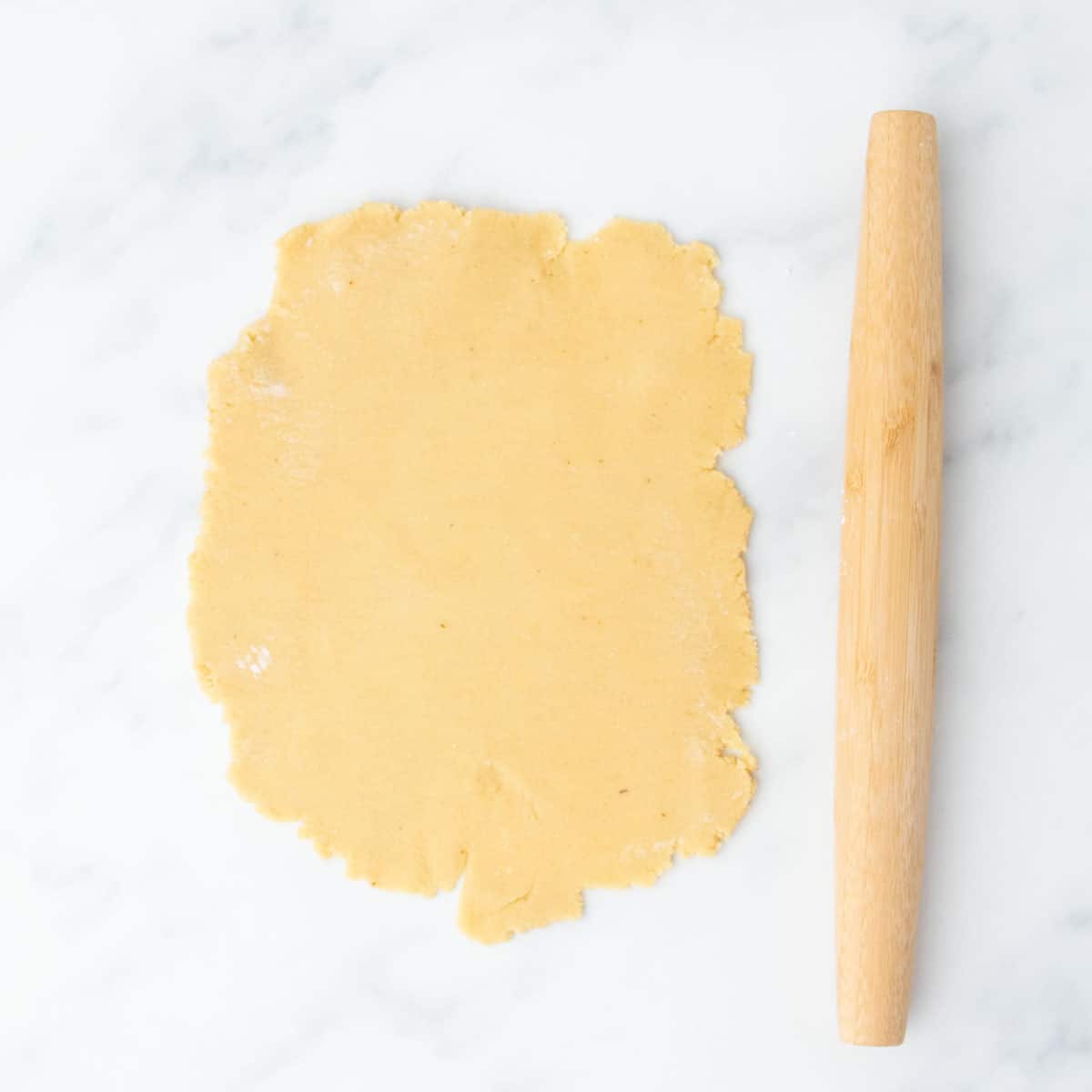
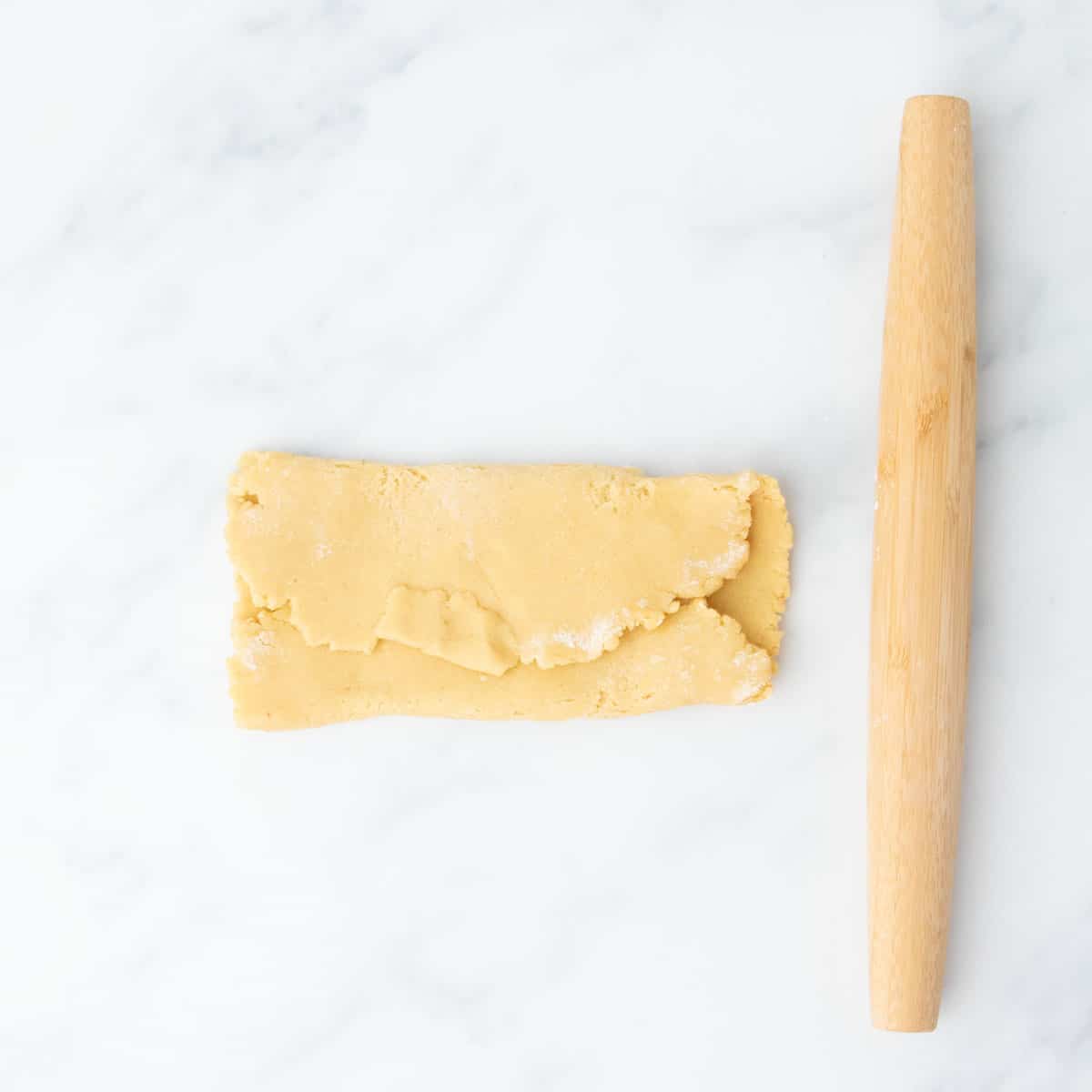
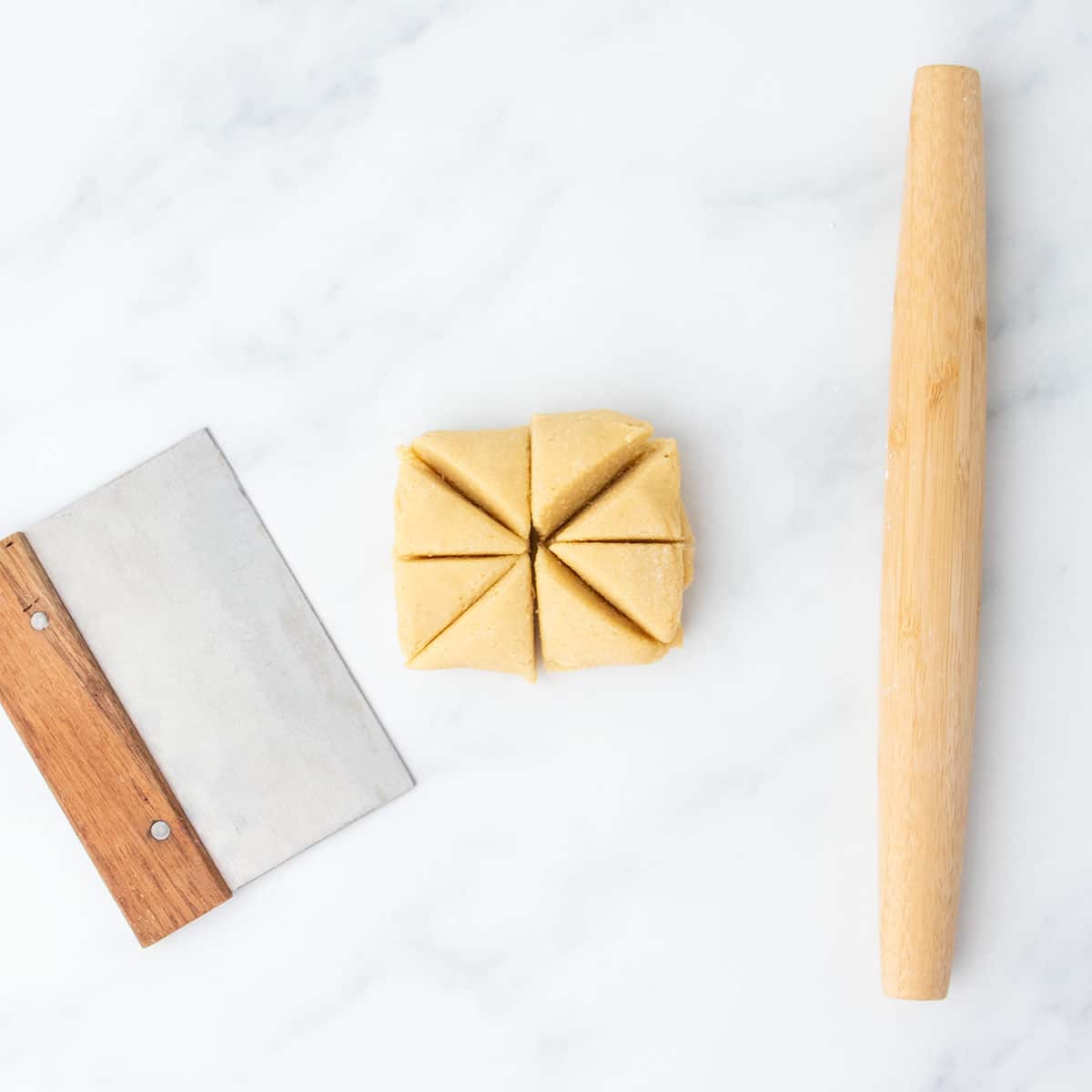
3. Shape the dough into rounds
Roll all 8 pieces of dough into smooth rounds between your palms. Transfer some excess dough to the first piece of dough, then use a rolling pin to roll the dough into a rough round about 7-inches in diameter so there's excess to trim. Sprinkle the dough lightly with tapioca starch to absorb some of the moisture so the dough is less sticky.
💡 A pro tip for perfectly round tortillas is to cut off excess with a a 6-inch metal cake cutter or metal lid of a pot. Remove the excess, and add it to the next portion. You can skip this step and just have messier edges, or use a knife to trim the rough parts.
The tortillas should be thin enough to be transparent enough that you can see your hand through them when you pick one up. That's how you know they're rolled thin enough.
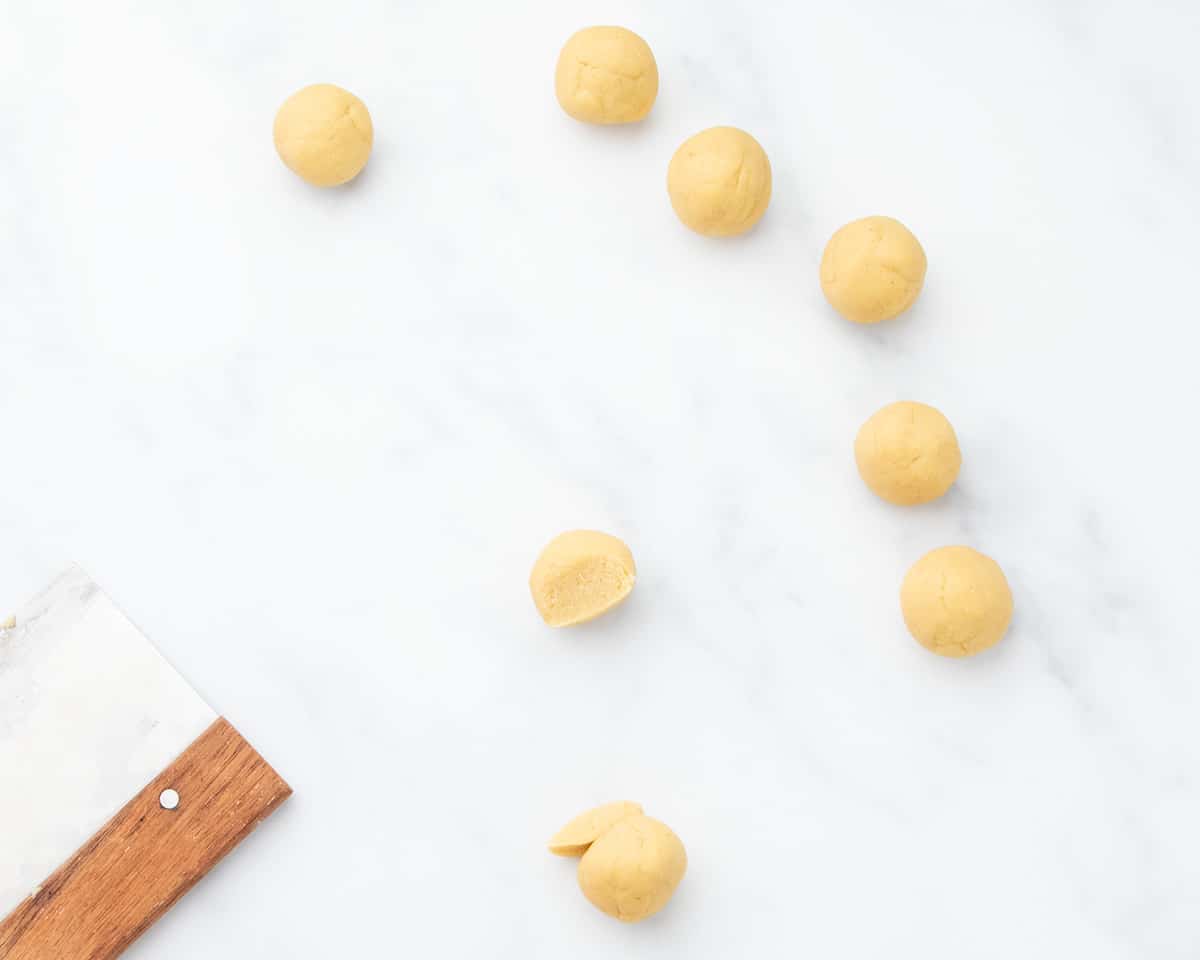
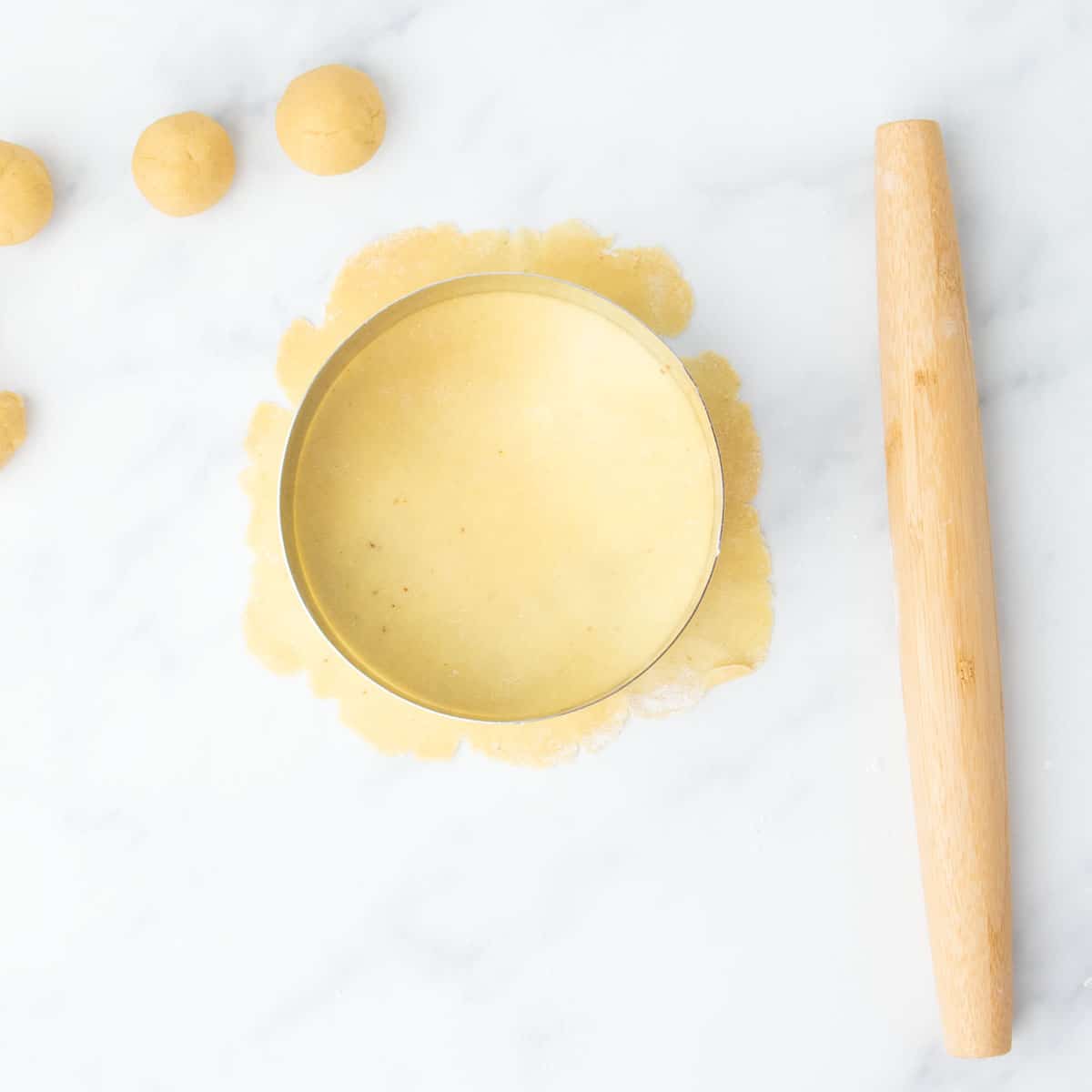
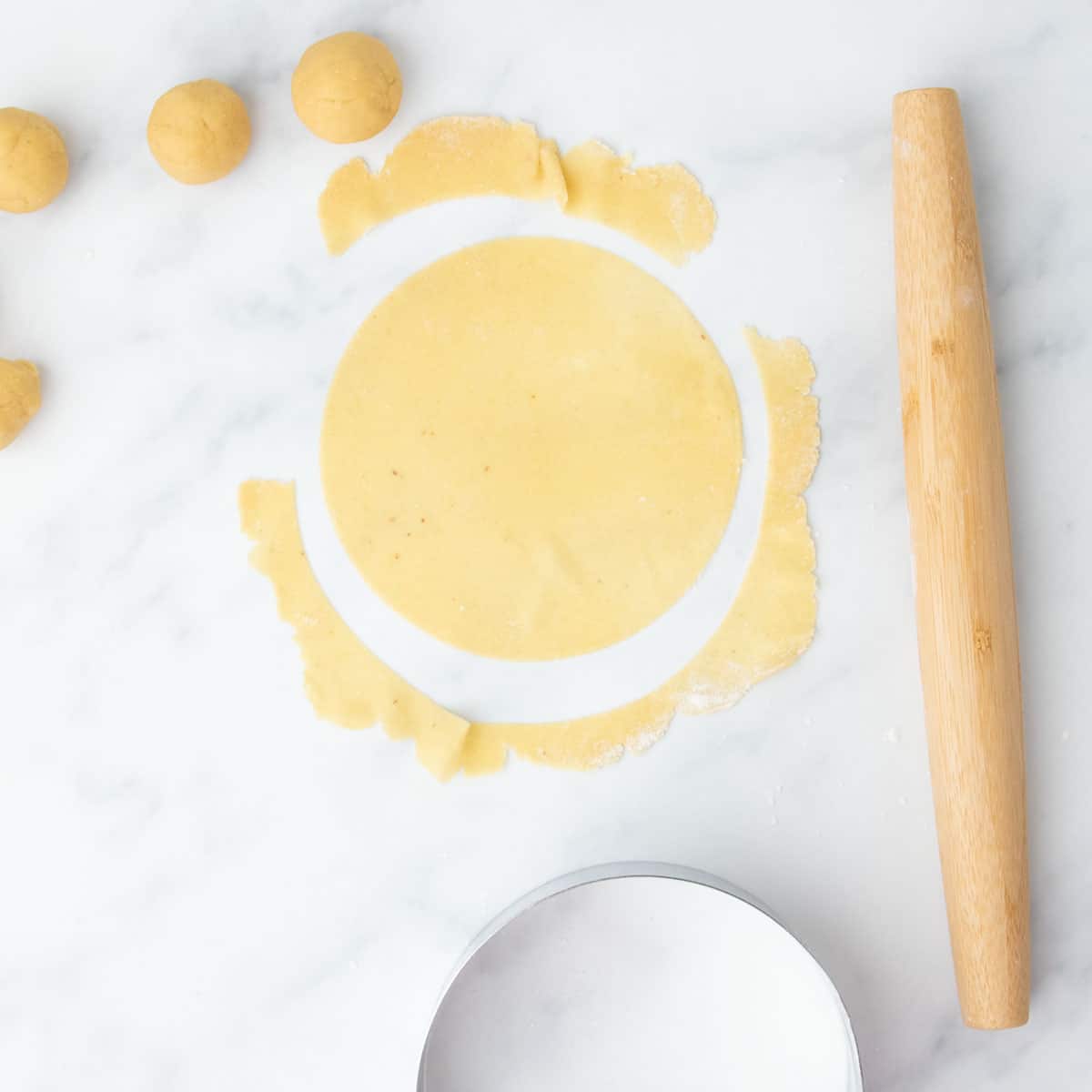
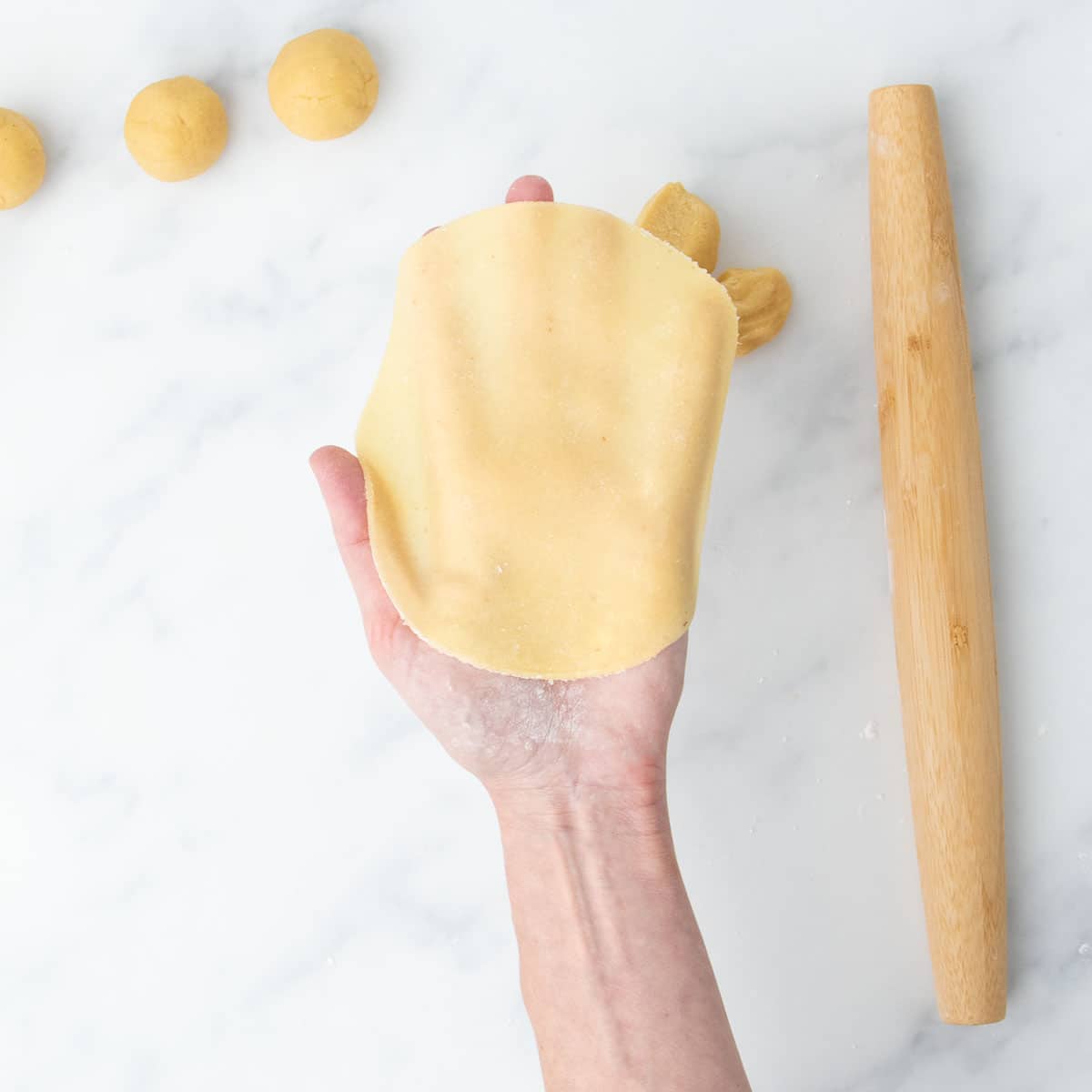
4. Cook the tortillas
I shape all of the rounds first, sprinkling them with tapioca starch to prevent them from sticking to each other. This way, I can cook them all at once when the skillet is hot and not worry one will burn while I'm shaping the next. You can shape and cook each raw round as it's ready, though.
Heat a griddle to 375°F or a cast iron skillet for at least 5 minutes or medium-high heat. Try adding a small piece of trimmed dough to the skillet and press it down with a spatula. It should start to cook very quickly when it's hot enough.
Place the first shaped tortilla on the hot skillet and press down firmly with a large spatula to force the whole round to make contact with the hot surface. Cook until bubbles form, then flip back and forth a couple times until the tortilla is opaque and has some browning on both sides. Stack the tortillas on top of one another covered in a tea towel and serve.
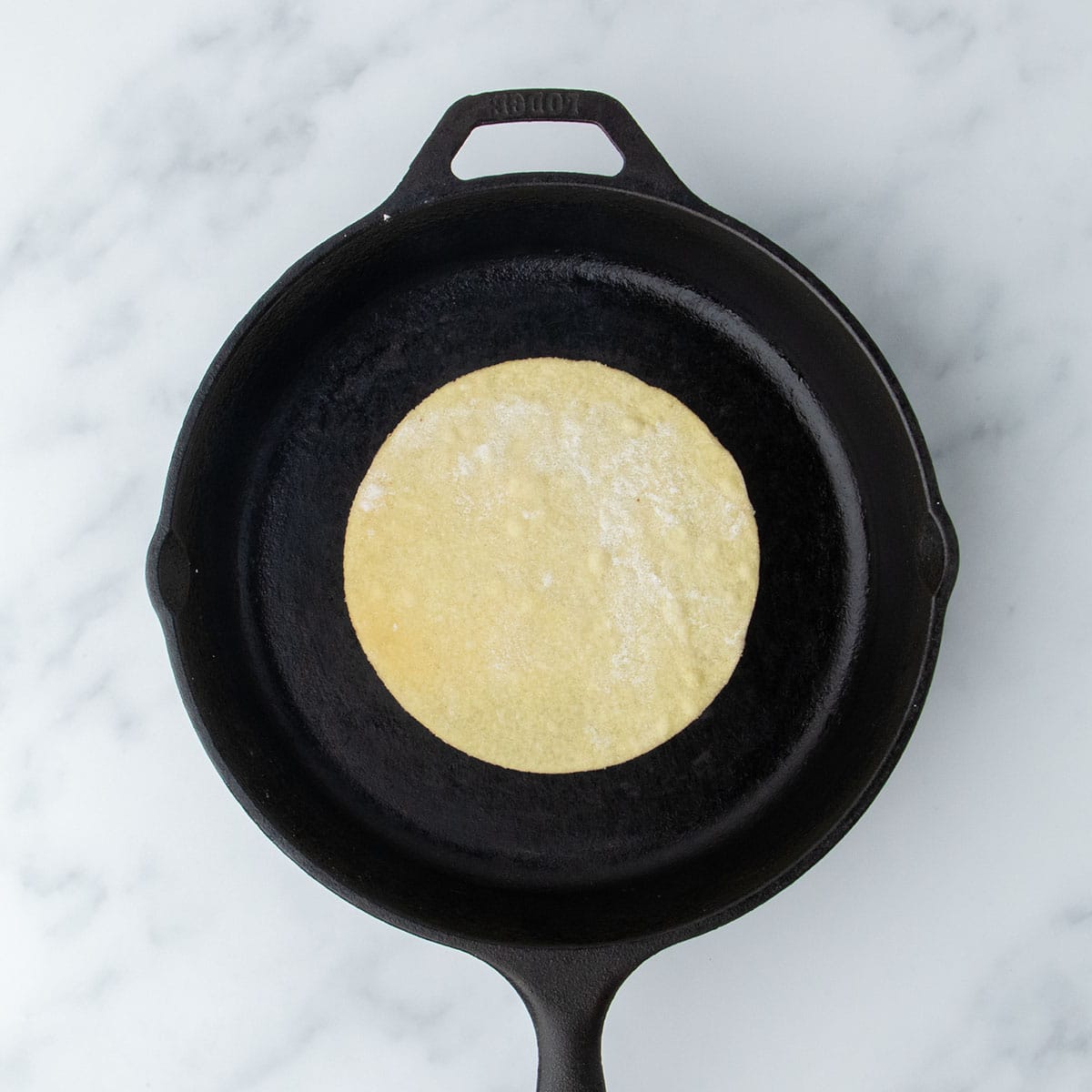
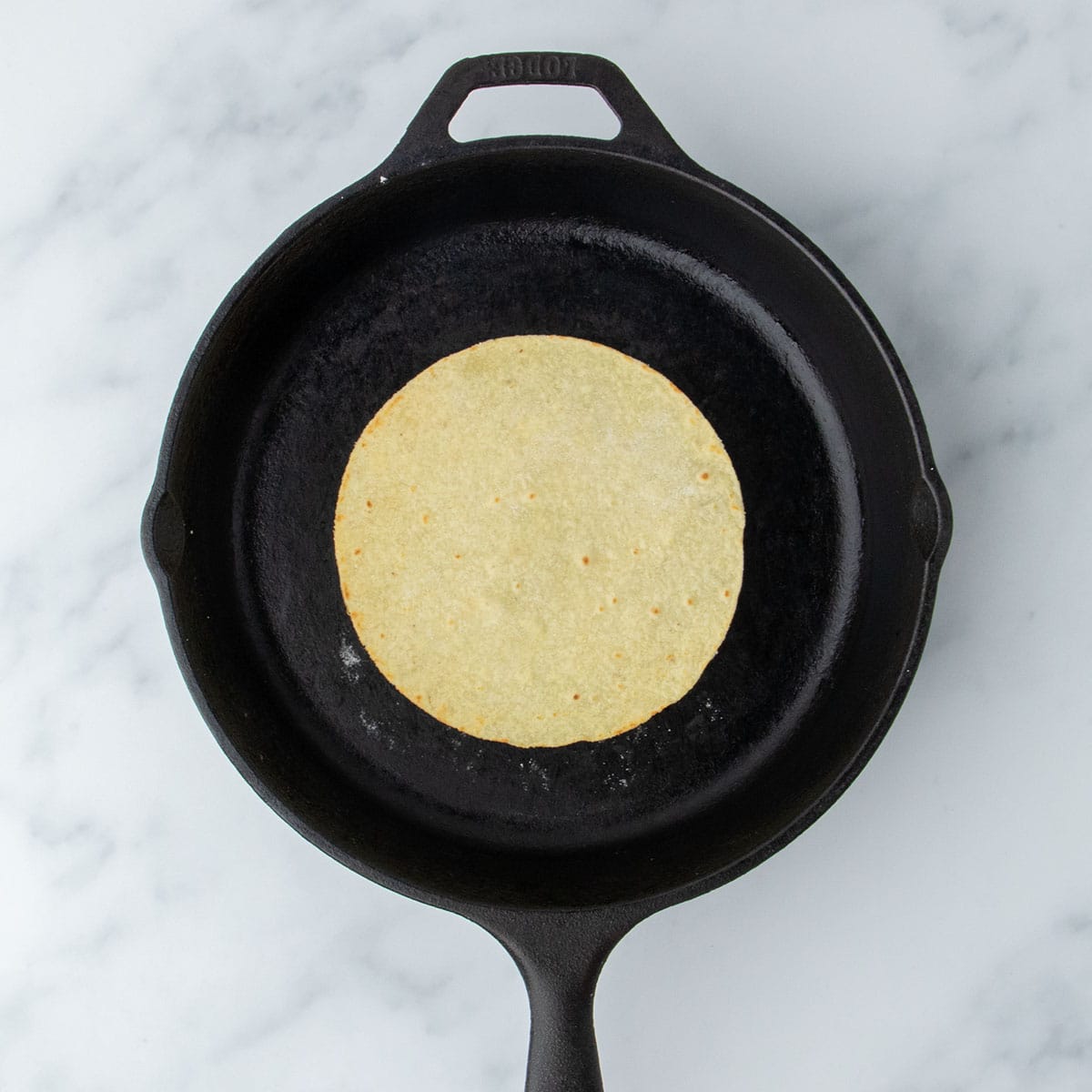
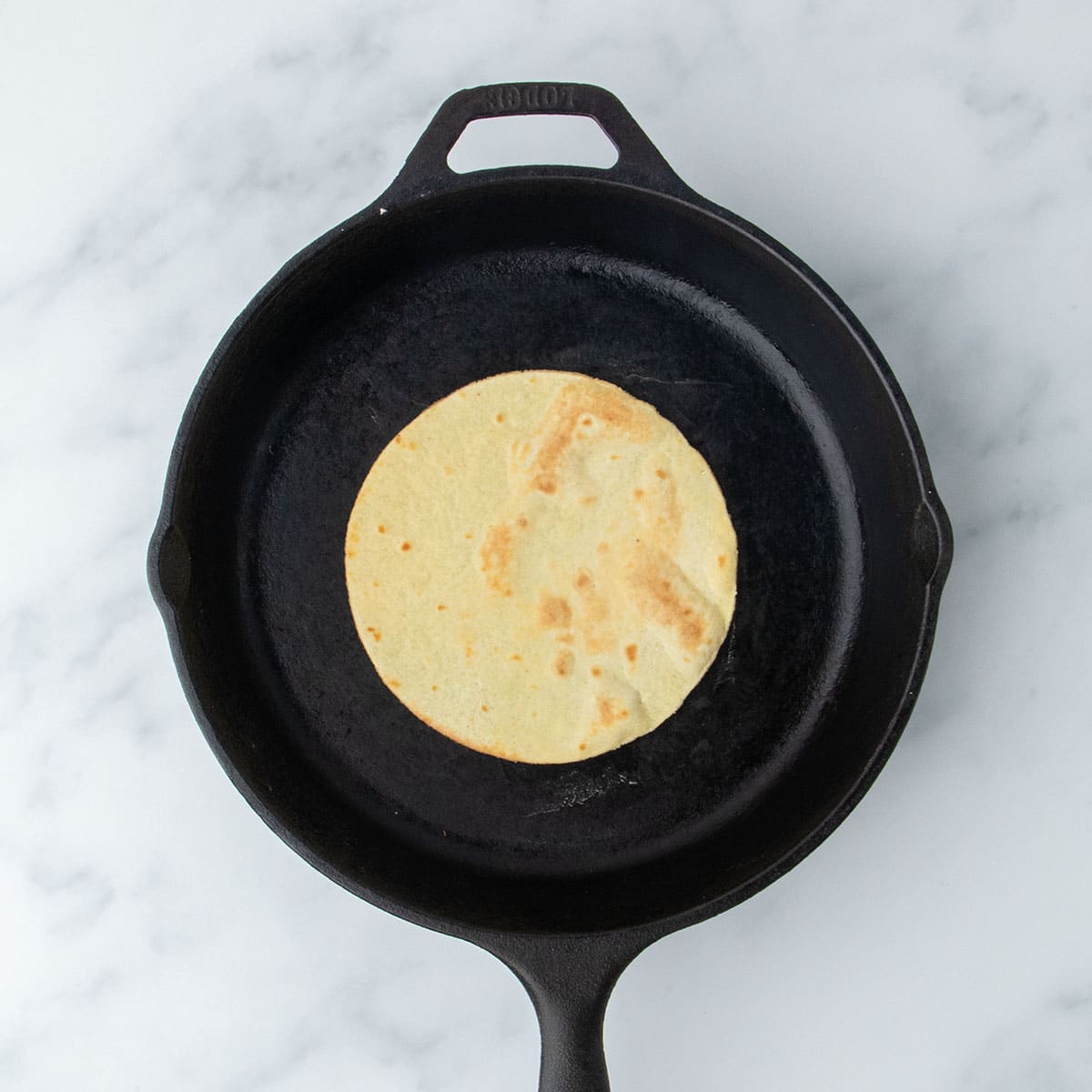
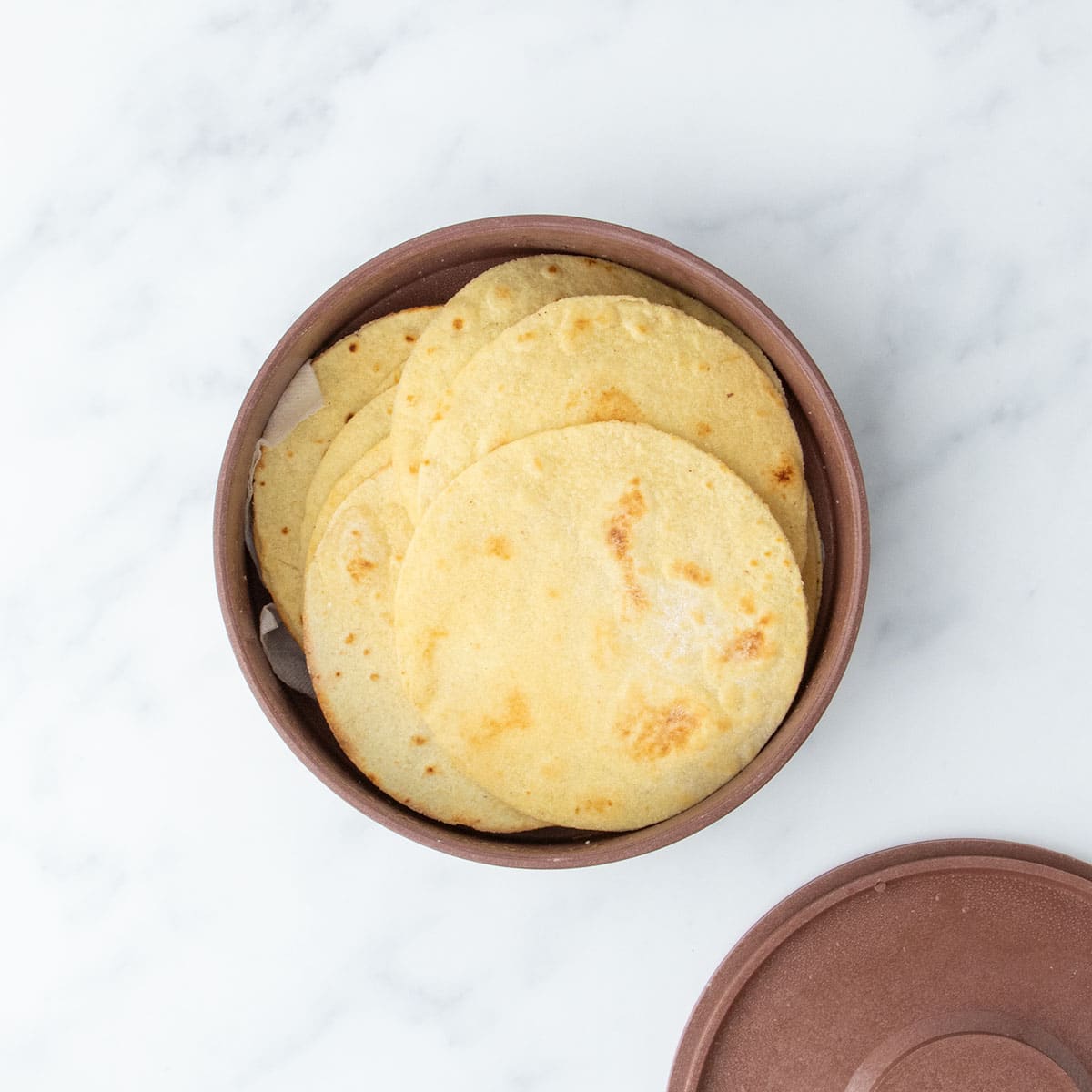
Expert tips
These tortillas have a few things in common with all my other gluten free tortilla recipes, but also call for some special handling. Here are some tips for success:
Firm up a too-soft dough
If you find that the dough is just too wet to roll out properly, knead more coconut flour into the dough by the pinch, and try shaping it again. Or knead in some tapioca starch to absorb some of the fat from the almond flour, and keep sprinkling tapioca starch to keep the dough from cracking and sticking as you roll.
Add extra dough to the first piece
After you divide the dough into 8 equal pieces, remove about 1/4 of the dough from one piece and add it to another. The extra dough makes rolling out the dough thin enough so much easier, and the excess dough gets trimmed and added to the next portion.
You can start with a tortilla press
It won't press the dough thin enough, but it's a good way to start. Line it with parchment paper or plastic to keep the dough from sticking to it, then then use a rolling pin to roll it thin enough.
Use a cake cutter or pot lid for clean edges
I used a 6-inch cake cutter to get neat edges on the tortillas. It's a very useful little trinket to have in the kitchen, but it's totally not necessary at all. The lid of a pot works great for the same purpose, or rough edges left intact are of course perfectly fine.
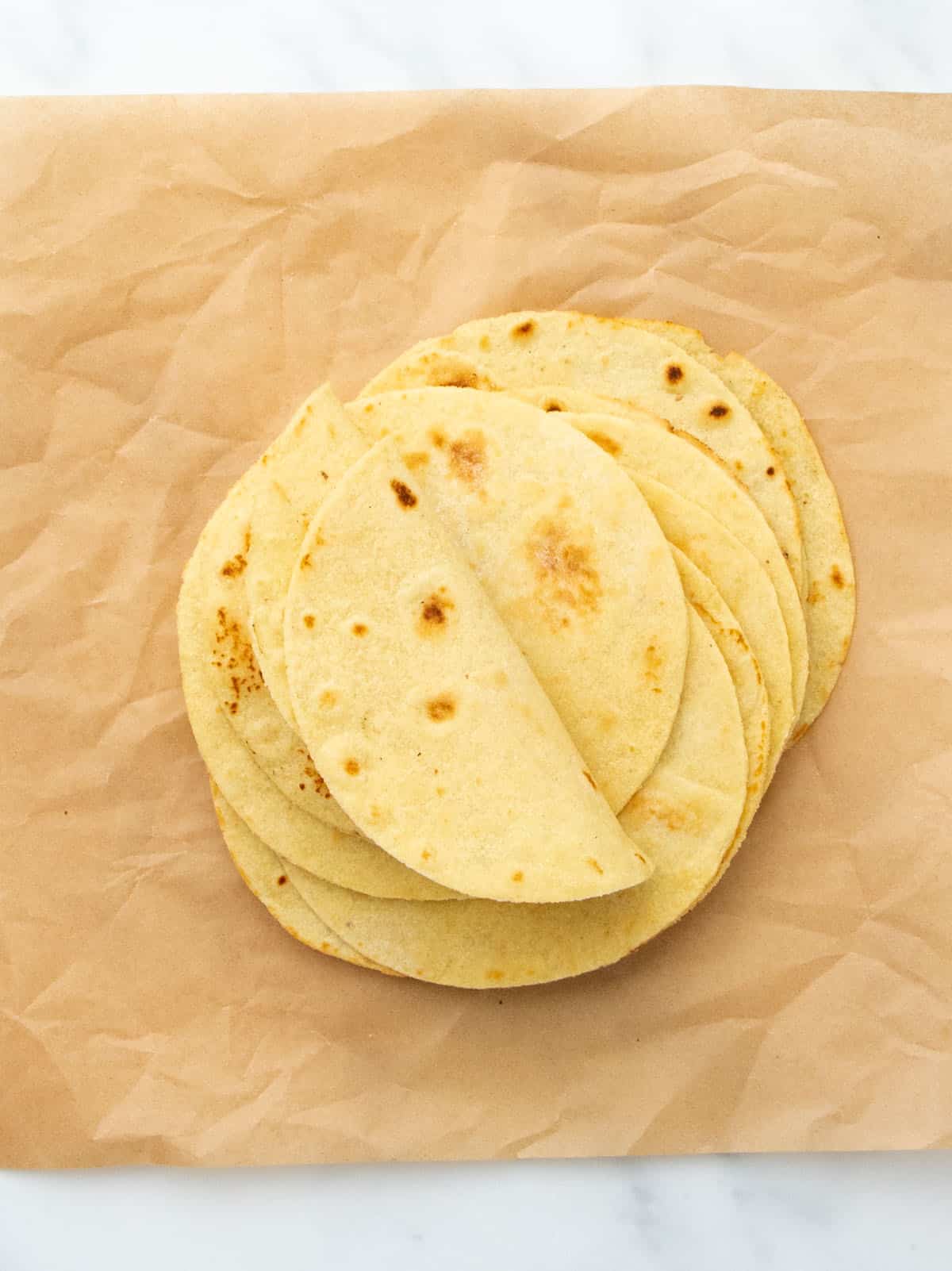
Ingredient substitutions
These tortillas are already dairy free, but here are some ideas for replacing other potential allergens:
Almond flour-free
You should be able to use finely ground cashew flour or hazelnut flour in place of almond flour.
Nut-free
Try sunflower seed flour, but the tortillas may turn green. The chlorophyll in the sunflower seeds reacts with baking powder, leading to a harmless green color.
Coconut flour-free
I tested this recipe with 6 tablespoons (48 g) of tapioca starch/flour in place of the coconut flour, and it worked. The dough isn't quite as easy to handle, and the tortillas tend not to bend as well right away. They were more flexible the next day when stored in a sealed plastic zip-top bag with a moistened paper towel. Keep in mind that the tortillas will be higher in carbohydrates if made with tapioca in place of coconut flour.
Egg free
I recommend trying 1 “chia egg” (1 tablespoon ground chia seeds + 1 tablespoon lukewarm water, mixed and allowed to gel) or a “flax egg” in place of the egg. Bob's Red Mill egg replacer may also work.
Xanthan gum-free
Guar gum should work instead. You can also try using 8 grams of finely ground blonde psyllium husk to the dry ingredients in place of 4 grams of xanthan gum before adding the warm water.
Tapioca starch
Instead of using tapioca starch to sprinkle during shaping, you can use finely ground rice flour, arrowroot, cornstarch, or potato starch. You can skip the starch and roll between sheets of parchment paper or plastic wrap, but your tortillas will have crinkle lines in them.
Almond Flour Tortillas Recipe
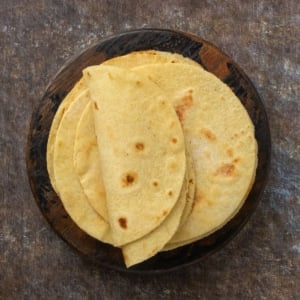
Equipment
- Food processor fitted with steel blade (mini chop works really well) optional
- 6-inch metal cake cutter (or metal lid of a pot of similar size) optional
- Cast iron skillet or nonstick griddle (or nonstick skillet)
Ingredients
- 13 tablespoons (98 g) finely ground blanched almond flour, See Recipe Notes
- ¼ cup (28 g) coconut flour, See Recipe Notes
- 1 teaspoon (4 g) xanthan gum, See Recipe Notes
- 1 teaspoon baking powder
- ½ teaspoon kosher salt
- 1 (50 g (weighed out of shell)) egg, at room temperature, lightly beaten
- 2 tablespoons (1 fluid ounce) lukewarm water, plus more as necessary
- tapioca starch/flour, for dusting during shaping (optional)
Instructions
Prepare the dough
- In a bowl or the bowl of a food processor fitted with the steel blade, place the almond flour, coconut flour, xanthan gum, baking powder, and salt. Whisk or pulse to combine.
- Add the beaten egg and 2 tablespoons of water. Pulse or mix to combine.
- If the dough holds together well and feels moist but not wet, mix or process until it forms a cohesive dough. If using a food processor, process just until it forms a ball and mostly clears the dough from the bottom of the container.
- If the dough feels at all dry, knead or process in more water by the quarter teaspoonful until it reaches the proper consistency.
Let the dough rest
- Transfer the dough from the bowl or food processor to a piece of plastic wrap, wrap tightly and store in the refrigerator until you’re ready to make the tortillas (up to 7 days). It’s best to allow the dough to chill for at least 10 minutes.
Shape the tortillas
- Unwrap the chilled dough, knead in some of the optional tapioca starch to smooth out the dough, and roll it out into a rough rectangle. Fold it in thirds like a business letter, then fold in the sides to form a packet.
- Using a bench scraper or sharp knife, divide the packet it into 8 pieces of equal size. Roll each between your palms into a smooth ball. Remove about 1/4 of one ball and add it to another, and begin working with the larger piece of dough.
- Press the first piece of dough into a disk and place in on a large, clean surface. Use a rolling pin to roll the dough into a round about 7-inches in diameter, dusting lightly with the optional tapioca starch to prevent sticking as you work.
- In place of tapioca starch to prevent sticking, you can roll each piece of dough into a round between two sheets of parchment paper or plastic wrap.
- Use the cake cutter or pot lid to cut out a 6-inch round. Remove the excess dough trimmings and add them to the next piece of dough, the one from which you had removed 1/4.
- Repeat the process with the next piece of dough, transferring excess to the one after it. Sprinkle the raw tortillas lightly with tapioca starch to prevent them from sticking to each other.
Cook them
- When you’re ready to make the tortillas, heat a nonstick or cast iron griddle over medium-high heat for at least 5 minutes. If using an electric griddle with a temperature gauge, heat it to 375°F.
- Place the shaped, raw tortilla on the skillet or hot griddle and press down with a wide, flat spatula. Allow to cook until bubbles start to form (about 20 seconds), then flip and press down until the tortilla looks opaque on both sides and is browned in spots. Flip again to brown more on the first side.
- Repeat with the remaining dough, stacking the warm tortillas on top of one another.
Storage
- Serve immediately, or place a stack of cooked tortillas in a zip-top plastic bag or tortilla warmer with a lid. Place a moistened paper towel into the bag before sealing it tightly. This will help keep them moist and pliable.
- They can be refreshed in a hot, dry skillet before serving if desired.
Video
Notes
Be sure you're using finely ground and sifted blanched almond flour with its skins removed, not almond meal, which has its skins intact and is more coarsely ground. About coconut flour
In place of coconut flour, you can use 6 tablespoons (48 g) of tapioca starch/flour. The tortilla dough is a bit more fragile and the tortillas a bit less flexible, but the recipe still works. About xanthan gum
You can use an equal amount of guar gum or konjac powder, or 8 grams finely ground blonde psyllium husk powder, in its place for a similar, although not exact, results. Adapted from Farm To Jar.
Nutrition
Nutrition information is automatically calculated, so should only be used as an approximation.
Storage instructions
You can wrap and store in the refrigerator the unshaped, raw dough (or shaped into rounds) wrapped tightly in plastic wrap for up to 1 week.
If you're not serving the tortillas immediately, place them in a stack in a plastic zip-top bag or tortilla warmer lined with a slightly wet paper towel to retain moisture. They will stay fresh that way for up to 3 days at room temperature, and up to a week the refrigerator in the plastic bag. If the towel dries out, moisten it again. You can always refresh the tortillas in a hot dry skillet.
For longer storage, wrap the stack of tortillas tightly in plastic wrap, then place in a freezer-safe zip-top bag, and squeeze out all the air you can. Freeze for up to 3 months. Defrost in the refrigerator or at room temperature, and refresh in a hot, dry skillet.
FAQs
No, Mission brand Carb Balance wraps are not gluten free! Some of the marketing for those low carb wraps refers to them as “keto friendly,” but the second and third ingredients are wheat starch and wheat flour, and the package states that it contains wheat. Wheat is a gluten-containing grain and must be avoided on a gluten free diet.
They don't contain any grains, dairy, or refined sugars, so they should be considered Paleo, yes.
They're soft and flexible. They are only crispy if they're overcooked, which can happen in a too-hot skillet that burns the almond flour or for too long.
No! I don't usually use a tortilla press and it's not ever going to roll the dough thin enough. But some people like to use one to get started.
No, you have to cook them on a skillet or griddle to get the right texture. They would probably burn on one side before you got a chance to flip them to cook the second side.
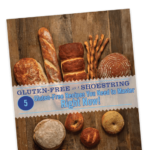

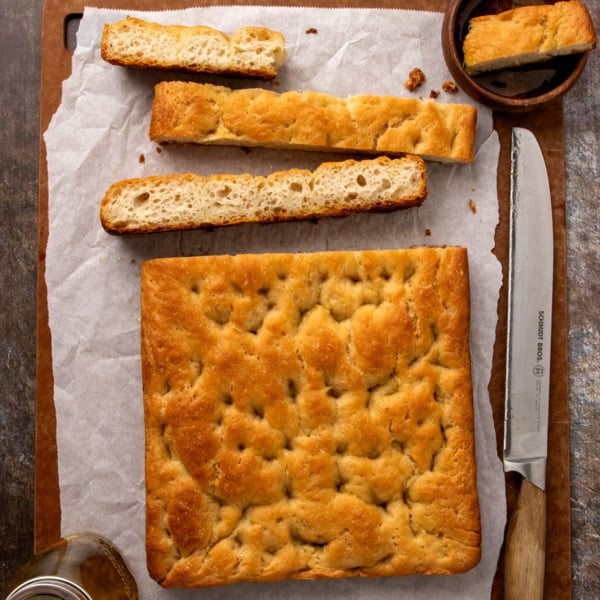
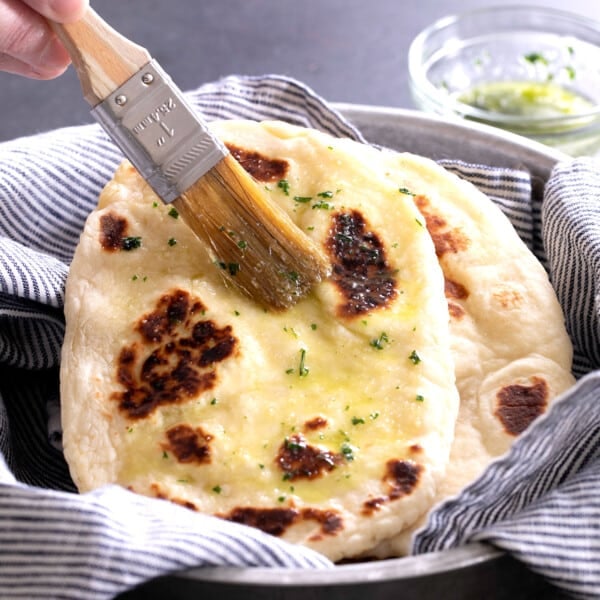
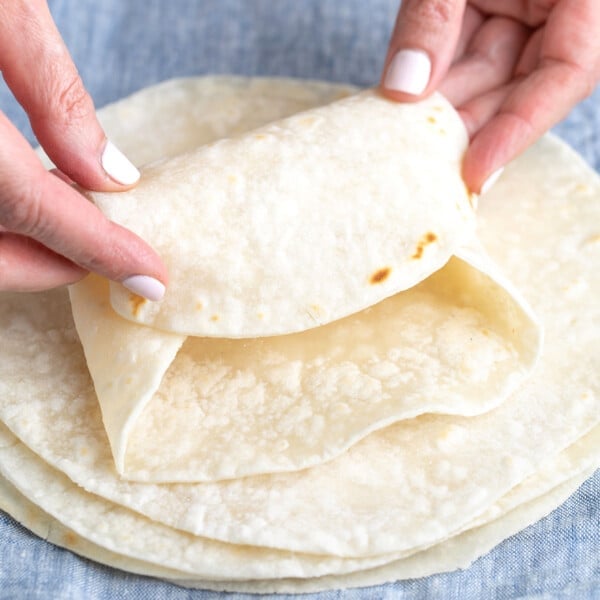
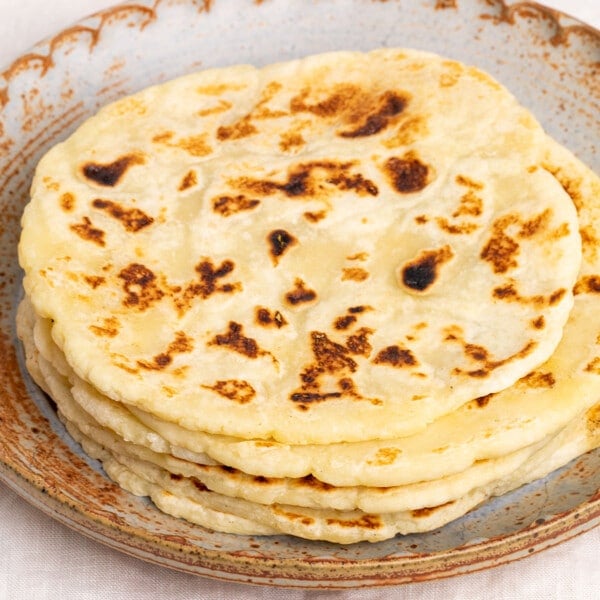









This has no measurements
The only ingredient that doesn’t have a specific measurement is tapioca starch for dusting, which is common accepted usage in recipe writing. Every other ingredient has a specific amount in the recipe card, Claudia.
I had my doubts when I saw the small ball of dough produced by this recipe, but the end results proved to be an excellent tortilla. They were appetizibg with deep golden spots, rolled without breaking or tearing, and tasted great. I made these because I didn’t want to go to the grocery store ( 30 minutes away), and was making fajitas for dinner. All ingredients were in my pantry. These are superior to the cassava root tortillas at my grocery store.